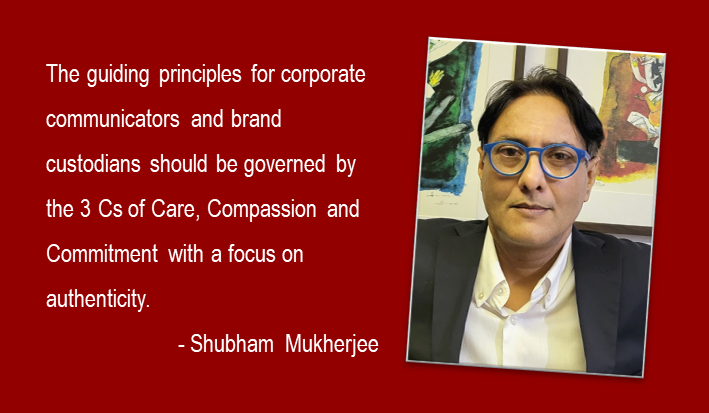You reap as you sow! We have heard these five words in various contexts ranging from spiritual upliftment to karmic retribution and it often waxes and wanes between the superficial and the profound. But here we will focus on what you have to sow to build reputation and create the right impact for your brand.
Communication professionals often have to carry the cross of a crisis in a company. Therefore they need to start early to build, amplify and manage the narrative in their company in such a way that it shields the brand from the shocks of a crisis. It’s about ensuring the right image of the brand is being projected to build trust, goodwill, legitimacy and advocacy. These act as a Kevlar and insulates it from any potential negativity. The idea is to think beyond promoting just the products of the company – which is the here and now approach.
I’ve often observed that a brand that invests in people, planet and purpose tends to manage a crisis much better than one which is only focused on profits. It all comes down to how the entire stakeholder community – employees, business partners, regulators, investors and the media – views you.
To begin with, why are we talking about a crisis? We have seen how a black-swan event like Covid-19 upended our lives and disrupted the world of business within weeks. Often when caught by surprise and changed business dynamics companies are not able to respond in the most appropriate way, leading to situations like job losses, decelerating sales, production constraints and a resultant hit on profits. Sometimes, it’s also about data leaks, regulatory knuckle knocks and sub-optimal customer service – all of which lead to loss of reputation.
Often the ingredients which build reputation such as superior customer service, social welfare, product quality and people practices are beyond the purview of corporate communication teams. But it’s the responsibility of corporate communicators to utilize these ingredients to create a narrative which is reputation-accretive, and takes away from any crisis or sudden negativity surrounding the brand.
How do you do it? Often, it comes down to the very basics which people study in B-Schools. However, extra care needs to be taken to ensure that you are authentic and not seen as opportunistic. If we are able to do them right, we build the Teflon which insulates the brand from a crisis. Here are seven strategies that will help brand custodians build and drive reputation.
Emphasising nation building: Every company worth its salt contributes to the economy, creates jobs and serves the ecosystem on which it thrives. For instance, a company in oil and gas contributes to bringing down forex outgoes in an oil-dependent economy, while those in the digital domain may be bridging the digital divide and creating jobs. Similarly, a financial services company contributes to driving financial inclusion. These are all important elements contributing to a country’s balanced growth. For some this is their job. Some others institutionalize it as a part of their purpose. It’s important for communication teams to amplify that purpose enough for stakeholders to understand the bigger picture and the reason for the brand’s existence. It may include nudging advertising teams to capture that sentiment or guiding leadership teams to lend their voice to that raison d’etre during interviews and internal addresses to instill both purpose and pride. The result – your stakeholders would get a reinforced message that you are not just chasing profits.
Showcasing social welfare & climate action: Corporate philanthropy has existed much before the government-mandated Corporate Social Responsibility (CSR) programmes came into effect and a lot of corporates go much beyond those mandates. Lately, there has been a growth in the constructive dialogue across governments, corporates and the social sector on Environment Social and Governance (ESG) issues – key to tackling the impending climate crisis. Investors now take active interest in companies that have taken cognizance of issues around people, planet and purpose valuing ESG-compliant companies better. Most progressive companies are doing a lot of great work across CSR and ESG because they genuinely care. It’s important for the corporate communication team to highlight that across platforms without being in your face and appearing opportunistic. A third-party endorsement around these issues go a long way in taking the narrative to the next level. Think industry committee memberships for the leadership team, an annual ESG Report and credible awards.
Harnessing the innovation prowess: If you were to do a straw poll of CEOs across sectors and geographies on what’s a key recipe for growth, they will rate innovation on top. Companies are going beyond product innovation to innovate across the value chain and actively utilizing digital tools such as Artificial Intelligence, AR and VR to increase productivity and to make it simpler and easier to connect with their customers. Companies are also rated on how innovative they are and it helps if corporate communication teams go beyond just creating soundbites for the leadership team on innovation measures to find real branding opportunities to take the high ground on the topic. Think Thought Leadership Reports in partnership with credible expert platforms.
Celebrating the customer: When you think of the most highly valued global companies on Wall Street, one thing is common between all of them – customer obsession. Customer-centricity or customer obsession is front and centre for all consumer-led companies as they compete for a share of the customer’s wallet. Companies have elaborate strategies to create excitement and engagement with their customers and build a long-term association. Corporate Communication teams need to have a 360 degree plan to capture the customer service story in its entirety through interviews, authored articles, and participation in customer service excellence awards to amplify the work being done to serve this key stakeholder. It’s also another way to the customer’s heart and support business.
Building thought leadership: Key stakeholders such as regulators, the government, media, employees, customers and business partners often judge a company by the quality of thought leadership as also the heft of the leadership team in the industry. It’s the duty of the communication team to ensure they have a seat on the table at top industry platforms and amplify it further through op-eds in key media. Also consider engagement with think tanks.
Engaging the investor: Shareholders are a partner in the company’s progress. It’s therefore important to keep them informed and routinely highlight performance both through the business media and, if listed, through analysts at brokerage houses. It would build understanding and admiration for the company’s financials and also establish a better connect with both investors and shareholders.
Integrating people and culture: With decelerating labour growth, superabundant capital and growing importance of intellectual property and customer networks, the balance of power is shifting from capital to labour. This became more visible during the pandemic as employee wellness became a top priority for companies. Organizations are engaging with their talent pool to create an environment where they can learn and grow, have a supporting ecosystem and align them with its values and vision. That also provides them a better appreciation of the culture of the firm, something more important than strategy when it comes to the success of a company. It’s the duty of the internal communication teams to continue to build on that narrative on both internal and external platforms. Not only does it help to retain talent and create brand ambassadors, it also attracts the best people at a time when the war for talent is getting acute. Think topics like care, safety, mental health and diversity & inclusion.
These seven pillars may appear intuitive on the face of it but should be a part of every communicator’s handbook to build reputation. The guiding principles of working on this strategy should be governed by the 3 Cs of Care, Compassion and Commitment with a focus on authenticity. Besides, it’s critical to use digital platforms to monitor on a virtually real-time basis what consumers are saying about the brand, amplify messages and measure impact. While these strategies protect the brand from sudden negativity they also enable in supporting businesses, make the company draw talent, create brand ambassadors internally and overall make it endearing to all its stakeholders. After all there is nothing better than turning your stakeholders into brand ambassadors and having them share positive experiences and word-of-mouth recommendations.
The views and opinions published here belong to the author and do not necessarily reflect the views and opinions of the publisher.



Be the first to comment on "Seven strategies to insulate brands from shocks and build reputation"